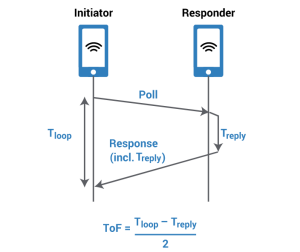
What is UWB?
Ultra-wideband (UWB) is a wireless technology that uses wideband radio waves which operate in higher frequency bands and use a higher bandwidth than other short-range technologies like Wi-Fi or Bluetooth®. This allows UWB to measure distance and determine position more accurately, leading to more secure applications.
How Does UWB Work?

UWB sends extremely short pulses to corresponding receivers that then translate those pulses into data. A UWB transmitter can calculate the Time-of-Flight (ToF) between devices, which is the roundtrip time of a submitted signal and its response to transmitted data; this is signal ranging. Because UWB uses a larger channel bandwidth (500 MHz or more) with short pulses averaging around two nanoseconds, it’s more accurate than other methods.
The Benefits of UWB
UWB offers numerous benefits as a relatively new wireless technology, including:
- Higher Security
Most technologies rely on a signal’s strength to determine distance and location. The stronger the signal, the closer the object. Hackers can use something called a relay station attack to amplify signals, trick these systems into thinking an object is closer than it is, and unlock doors.
Instead of depending upon signal strength, UWB uses ToF, ranging, and other techniques to determine the distance of an object. The concept is simple – measure the time it takes for the radio signal to travel and multiply by the speed of light (see Figure above) – but powerful as no one can hack time or the speed of light. So, if a hacker attempts to use a relay station attack to unlock a door, the UWB device will conclude the object is further away, not closer, and remain locked. - Better Accuracy
Since the time duration of the UWB’s pulse is in nanoseconds, it detects an object’s changes in position, motion, and direction accurately. It can locate objects down to less than 10 cm in line-of-sight or non-line-of-sight. - Real-time
UWB comes with a refresh rate of up to 1,000 times per second - 50x faster than satellite navigation like GPS. This translates into the capability to pinpoint a location in real-time even for fast-moving objects or people. - Multipath Effect
Due to its technology, UWB is less susceptible to the multipath effect compared to other technologies since it uses a wider bandwidth and shorter pulses. - Less Energy, Lower Costs
Since UWB uses short signal bursts and low-powered radio frequencies, it uses less power and is more affordable to operate. In short, it’s energy- and cost-efficient to use.
How UWB is Used
While the potential usage for UWB is virtually endless, there are real-world examples of how it’s already being used. We’ve narrowed it down to four categories:
- Smart cities and mobility
- Smart buildings and industrial
- Smart retail
- Smart home and consumer

As for day-to-day usage, UWB falls into three categories: hands-free access control; location-based services, and device-to-device (peer-to-peer) applications. These translate into the following use cases:
- Building Access – UWB technology can help you automatically open doors to a secure area within a building as you approach them.
- Indoor Navigation – UWB can help you get precise navigation to your airport gate or a product on a shelf.
- Smart Home - Lights, speakers, thermostats, and any other connected device with UWB sensing capability can follow you from room to room, adjusting your preferences as you go.
- Car Access – UWB can help you unlock and start a car with a smartphone as soon as you approach using keyless entry and remote start.
- Asset Tracking – Companies like Boeing use UWB tags to track assets like tools, carts, and other items.
- Wireless Payments – By now, we’re used to contactless payments using NFC. UWB is more secure and lets you leave your smartphone in your pocket.
- Smart Retail – Get useful information or sales promotions about a product you just picked up.
- Sports & Fitness Tracking – The NFL uses UWB transmitters on players’ shoulder pads to track them on the field for instant replay animations and can be updated around 2,000 times per second.
The Future of UWB
The potential applications of UWB keep growing. In fact, according to the FCC website, there were 92 UWB-enabled products granted FCC certification in 2022. Thanks to changes in FCC regulations and overall adoption by major technology companies, UWB growth is assured to continue exponentially in the future.
Forthcoming UWB potential exists in all the use cases we mentioned earlier, as well as in public transportation, city infrastructure like parking and traffic flow, medical histories and diagnoses, real-time video streaming, and more. Although UWB isn’t new, it definitely has an established future in the Internet of Things (IoT) and the Industrial Internet of Things (IIoT) and is primed to make new technology more secure, accurate, efficient, and effective.